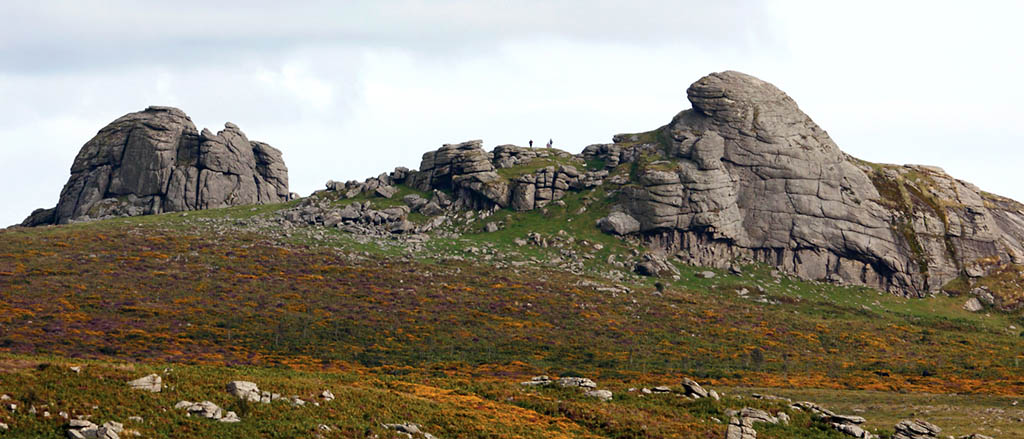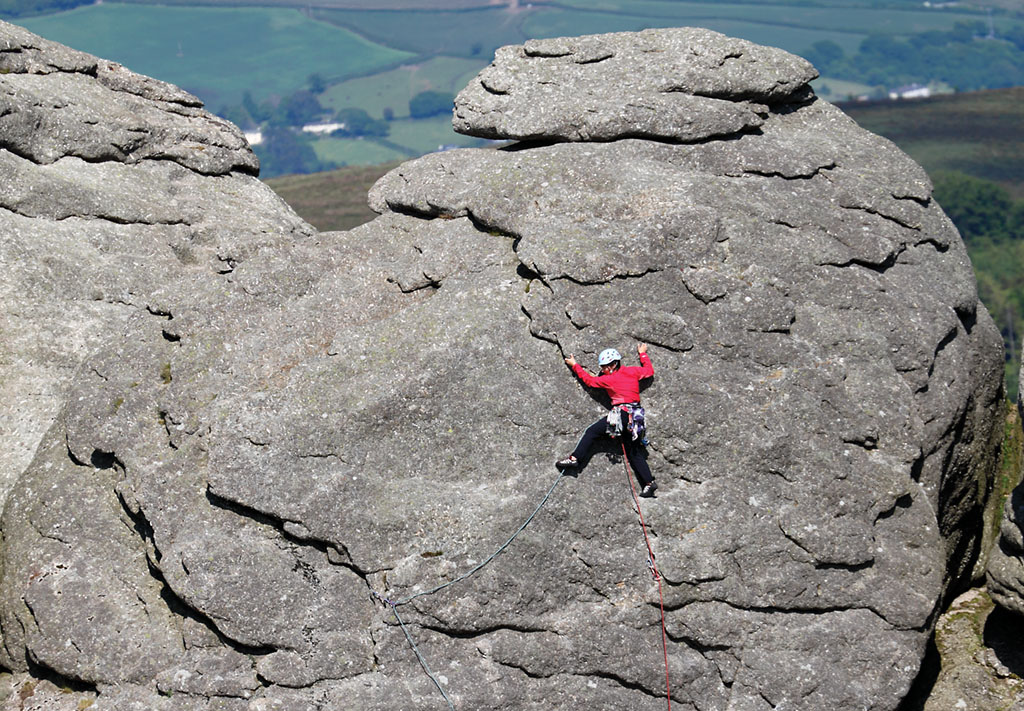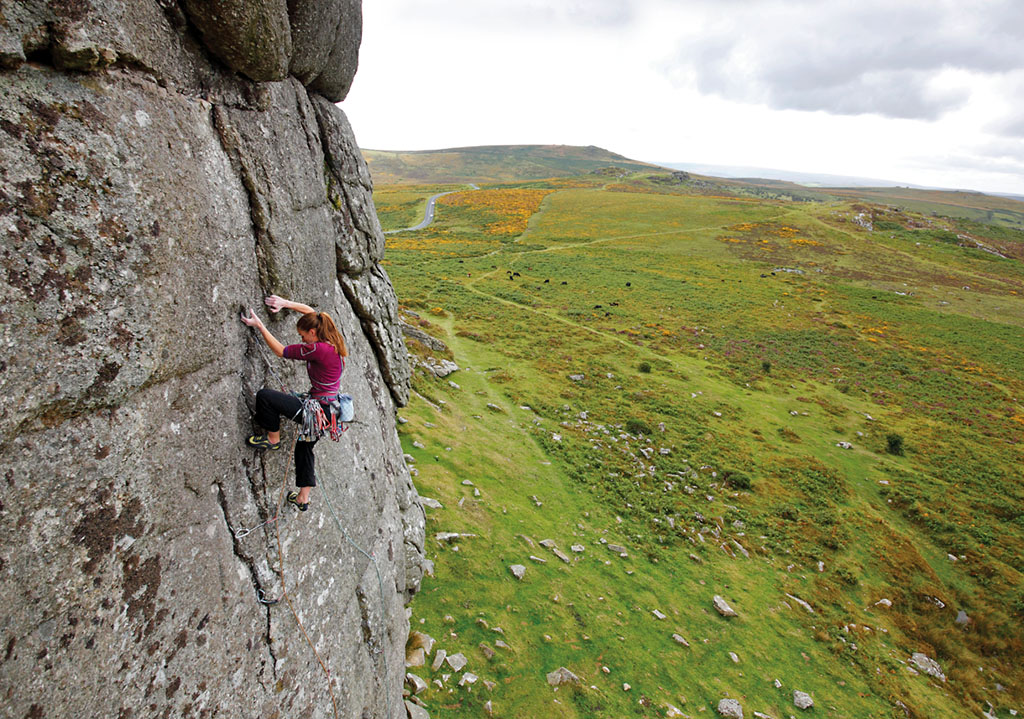Hay Tor – Dartmoor Granite Trad Climbing
- Tuesday 13th February 2024
by Iain Peters
Dartmoor is full of prominent features but two large granite structures stand out from the rest. Hay Tor is the largest and most spectacular of the hundreds scattered across the moor. On a clear day, you can see as far as Portland Bill from its summit, take cute photos of Dartmoor ponies, sample some excellent climbing then enjoy an ice cream in either of its two large car parks before heading down to Widecombe for a well-deserved pint at the Rugglestone Inn.
 I prefer Athur, the alternative and probably apocryphal druidic name for the tor meaning Rock of the Sun to go with the legend that its summit was once used for human sacrifice. It must have been hard work hauling writhing and screaming victims up to the summit rock basins long before the steps were carved, allegedly for a visit by Queen Victoria. There’s still a tricky wide stride across a gully below the summit and even if she’d made it to the top a sneaky wind could easily have blown her voluminous skirts up around her bonnet to reveal the royal knickers; she would not have been amused.
I prefer Athur, the alternative and probably apocryphal druidic name for the tor meaning Rock of the Sun to go with the legend that its summit was once used for human sacrifice. It must have been hard work hauling writhing and screaming victims up to the summit rock basins long before the steps were carved, allegedly for a visit by Queen Victoria. There’s still a tricky wide stride across a gully below the summit and even if she’d made it to the top a sneaky wind could easily have blown her voluminous skirts up around her bonnet to reveal the royal knickers; she would not have been amused.
Human sacrifice and imperial bloomers aside, the tor gives some of the best, most varied and longest climbing on Dartmoor all on solid granite, often with a friendly flake in just the right place, although confidence in making balancey friction moves on crystals and slopers in the characteristic rounded cracks is also important. A word of warning to lovers of gritstone jamming; the crystals in the interior of a Dartmoor crack are bloodsuckers.
Hay Tor is officially an avenue tor with two summit blocks separated by a wide grassy sward. High Man, apparently the bigger of the two, is the most popular so if you don’t mind performing in front of a curious human audience or indifferent Dartmoor ponies, far more interested in your sandwiches than your climbing, is probably a good place to start for a first-time visit. There are good routes on three of its four facets.
High Man – West Face
The West Face overlooking the avenue is probably the most popular with a good spread of grades. At its lower right-hand end there are a series of swashbuckling boulder problems, redeemed by generally good landings, including Pat Littlejohn’s D’Artagnan, given only HVS 5c because the crux move, a long reach to a mediocre hold, often ends as a backwards jump and by the time protection appears it’s more or less all over.
Anyone owning the earlier Dartmoor guides by Lawder or Moulam, should not confuse this D’Artagnan with the Mod of the same name up a gentle crack in a slab to the left. Haggis (HVS 5b) is one of a series of fine routes put up by instructors from The Outward Bound School near Ashburton in the 1960s and is a good warm-up for the photogenic and steep lines up the bulging wall at the north end of this face. For something easier, the sweep of wall left again has a couple of good offerings with Bulging Wall (VD) and Zig-Zag (D) taking slightly meandering lines up the wall.
 Hangover, first climbed by John Barry’s ex-Marine father, Joe, over 50 years ago used to be treated as a crowd-pleasing highball solo by locals, until a crucial flake snapped off unexpectedly raising the grade to E2, but this, and the parallel flakes taken by the aptly named Don’t Stop Now at 5c, do have adequate protection as long as one has enough left in the tank to place it. Near the base of the wall is the obvious challenge of Letterbox Wall. Discovering the key hold to gain a standing position on the ledge requires a degree of lateral thinking, and the exit moves up and left to escape are no pushover, so best to treat the lowly HS grade with a pinch of the proverbial.
Hangover, first climbed by John Barry’s ex-Marine father, Joe, over 50 years ago used to be treated as a crowd-pleasing highball solo by locals, until a crucial flake snapped off unexpectedly raising the grade to E2, but this, and the parallel flakes taken by the aptly named Don’t Stop Now at 5c, do have adequate protection as long as one has enough left in the tank to place it. Near the base of the wall is the obvious challenge of Letterbox Wall. Discovering the key hold to gain a standing position on the ledge requires a degree of lateral thinking, and the exit moves up and left to escape are no pushover, so best to treat the lowly HS grade with a pinch of the proverbial.
High Man – North Face
 Life gets more serious once you step around the corner into the shadowy North Face and a lot chillier except on sunny and windless summer evenings. Twenty metres of green and lichenous, albeit impressively, steep granite, seamed with shallow runnels and mossy cracks might send a shiver down many a spine. Five lines of possibility and five routes, none of which are graded less than the E4 flawed gem of Rough Diamond first climbed by Littlejohn and O’Sullivan. Make no mistake, these routes seem far bigger than their modest height and see few on-sight ascents, especially as the winter overflow from the sacrificial rock basins on the summit feeds the moss and algae turning the footholds into skidpans when wet and when crumbling disconcertingly into dust when dry, not exactly an inducement to have a go. Appearances can be deceptive and the stars say it all for this is moorland climbing of the highest quality.
Life gets more serious once you step around the corner into the shadowy North Face and a lot chillier except on sunny and windless summer evenings. Twenty metres of green and lichenous, albeit impressively, steep granite, seamed with shallow runnels and mossy cracks might send a shiver down many a spine. Five lines of possibility and five routes, none of which are graded less than the E4 flawed gem of Rough Diamond first climbed by Littlejohn and O’Sullivan. Make no mistake, these routes seem far bigger than their modest height and see few on-sight ascents, especially as the winter overflow from the sacrificial rock basins on the summit feeds the moss and algae turning the footholds into skidpans when wet and when crumbling disconcertingly into dust when dry, not exactly an inducement to have a go. Appearances can be deceptive and the stars say it all for this is moorland climbing of the highest quality.
All is not lost if sustained jamming and precarious layaways are not your bag because a few metres further on a massive detached flake leans against the mother cliff at a far more amenable angle, where finesse and balance are more important than strong fingers and forearms. The chimneys at each side of the flake might appeal to a few diehard traditionalists but they would be advised not to investigate the cave-like void behind too closely as it is often frequented by those who have been caught short after over-indulging on pasties and ice cream.
Best to stay off the oggies and lollipops until after you’ve enjoyed the friction padding on Vandal and the airy awkwardness of Ann immediately above. Given HVS 5b, the moves off the ground next to a couple of boreholes probably merit a respectable bouldering grade and lead past a curious pair of iron rods, known as feathers in pre-dynamite quarrying times and now provide a useful tape runner, before the easier but still bold slab climbing to the top of the flake. From there the logical finish is via an awkward pull into an obvious groove to gain the summit slabs. First climbed by Geoff Sutton, author of an early textbook on aid climbing, seconded by and named after his new bride, the ascent was made in November of all months whilst on their honeymoon; the marriage didn’t last.
The final worthwhile route is Canis (VS 4c) which climbs up to and over a large dog-tooth flake on the arête at the junction of the North and slabbier East Face. With no stones to roll off the summit, the finishing slabs can be covered in moss, but the holds once excavated are reasonable.
Low Man – West Face
Good though they undoubtedly are, the routes on the main tor have to give pride of place to a modest little lump of granite on the opposite side of the avenue, somewhat dismissively called Low Man. Take a short stroll down a boulder-strewn slope, beneath scrubby and undistinguished walls and suddenly all is revealed. Fifty metres high and double that in width, the West Face of Low Man is the most impressive sweep of pristine rock on Dartmoor.
The bulk of the crag consists of rough, crystalline folds of grey granite sitting on a plinth of a much more compact and weathered granite. Bulging overhangs mark the junction between the two types, with the consequence that muscles already complaining from the exertion required to pull through these roofs can baulk at the prospect of the steep but more technical ground still to come.
There’s not a poor route amongst the 20 or so on the main face, although unfortunately nothing easier than Severe and only two at that standard including the slight but pleasant enough Honeymoon Corner at the extreme left end. Close by is the aptly named Outward Bound, a typically exuberant creation of the late, great Tom Patey. Easy climbing leads up into the depths of a substantial roof where a protruding block provides space for a welcome sling and a decent hold. The next move is an elegant wide bridge for the tall or a wild swing for the rest of us aiming for a foothold out on the edge of air. Blind faith in the hope that there will be holds beyond, after all, we’re talking HVS 4c for God’s sake, is rewarded with jugs, a couple more urgent pulls and a friendly ledge to rest on; nothing hard remains.
Moving on past its more difficult but lesser doppelganger, The Flyer (E1 5c) leads to one of Dartmoor’s more memorable Severes, Raven’s Gully first climbed by Tony Moulam of Mur y Niwl fame. To call two triangular inset slabs dominated by an overhanging chimney a gully is somewhat of a misnomer, but who’s complaining because, with positive holds throughout and straightforward, if exposed, bridging at the top this raven is most definitely not the harbinger of all evil.
 It’s worth pausing before the final chimney to look across to a route that still asks difficult questions 50 years after its first ascent by one of Exeter’s finest, Frank Cannings. Interrogation (E3 6a) is arguably the best route of its grade in inland Devon following a natural sweeping line up a plumb vertical wall. Bold at the start, technical in its middle section and with a wild and delicate finish skirting a bulging headwall on crystals this is classic three-star climbing by anyone’s standards. Many scuttle left to seek respite on the belay ledge of Raven’s Gully but depending on rope drag and stamina pressing on in one long pitch might even be worthy of an extra E point.
It’s worth pausing before the final chimney to look across to a route that still asks difficult questions 50 years after its first ascent by one of Exeter’s finest, Frank Cannings. Interrogation (E3 6a) is arguably the best route of its grade in inland Devon following a natural sweeping line up a plumb vertical wall. Bold at the start, technical in its middle section and with a wild and delicate finish skirting a bulging headwall on crystals this is classic three-star climbing by anyone’s standards. Many scuttle left to seek respite on the belay ledge of Raven’s Gully but depending on rope drag and stamina pressing on in one long pitch might even be worthy of an extra E point.
If Interrogation is too much of a test, there’s the perfect antidote just around the corner with the immaculate Aviation. Graded somewhere in that happy no-man’s land between HVS and E1, the route epitomizes all that is best about Dartmoor climbing. Sprint up a compact pillar to an overhang blessed with a welcome crack, throw in a nice big cam or hex at eye level followed by a couple of equally secure fist jams, then pull hard and rest awhile in a niche. A change of pace is required to avoid the bulge above by a delicate tiptoe up and across to a slab and flake. If the runners are well-placed, you’ll be happy to continue boldly up a wide runnel that gradually eases as height is gained. Save the route for a fine summer’s evening when the crowds have drifted away, and the air is full of the plaintive cry of the curlews.
 Steve Bell’s contribution to Low Man, Igneous Pig (E3) is a tougher proposition that takes a strenuous, but delicate, direct line up the rock that Aviation sensibly avoids. Next in line is another Littlejohn granite master class, the obvious counter diagonal line that bisects Aviation, Rhinoceros (E3 6a). This is one powerful beast of a route whose horns will never be ground into dust for some Eastern love potion. It lurches into life with a hard series of pulls through the initial roof on thin flakes and takes a little while to gather momentum before charging at full speed up the obvious left-leaning groove before skidding to a halt beneath a final bulge that demands a more measured approach to gain the easier upper slabs.
Steve Bell’s contribution to Low Man, Igneous Pig (E3) is a tougher proposition that takes a strenuous, but delicate, direct line up the rock that Aviation sensibly avoids. Next in line is another Littlejohn granite master class, the obvious counter diagonal line that bisects Aviation, Rhinoceros (E3 6a). This is one powerful beast of a route whose horns will never be ground into dust for some Eastern love potion. It lurches into life with a hard series of pulls through the initial roof on thin flakes and takes a little while to gather momentum before charging at full speed up the obvious left-leaning groove before skidding to a halt beneath a final bulge that demands a more measured approach to gain the easier upper slabs.
With its somewhat morbid title Die Laughing (E5 6c) is a ferocious, holdless and still unrepeated direct finish by John Gaskins over the wicked bulge atop Rhinoceros’s groove and almost certainly undergraded. Also sharing the same start as Rhinoceros is the bold and very hard The Camel (E6 6c) which goes straight up a faint groove with only RPs for protection and has only recently received its first repeat without pre-placing the gear.
The roof now becomes more pronounced with even less in the way of holds, although the pessimistically named Blood Lust (E4 6b) powers its way up a flared, overhanging crack, usually with a tell-tale trail of blood marking the line. All good things come to an end but there are a couple more routes worth mentioning before the face disappears into the vegetated hillside. Levitation (HS 4b) is a very pleasant if wandering, excursion with good holds and protection tracing a friendlier path across delicate slabs and delectable cracks to gain the summit, whilst starting as for Levitation the Low Man Girdle (E3 6a) takes an uncompromising line following the distinctive horizontal fault that runs almost across to Raven’s Gully gradually increasing in difficulty to a climax on the wall of Interrogation. A second pitch across the Outward Bound buttress is somewhat of an anti-climax, but if further technical horizontal movement is needed then Dehydration (E2 5c) which follows a higher break is also worthwhile.
All these routes are described in the Climbers’ Club Dartmoor guidebook so pray for a decent summer, then take a break from that rush to West Cornwall and discover these superb rough diamonds high on the Devon moors, they won’t disappoint.

